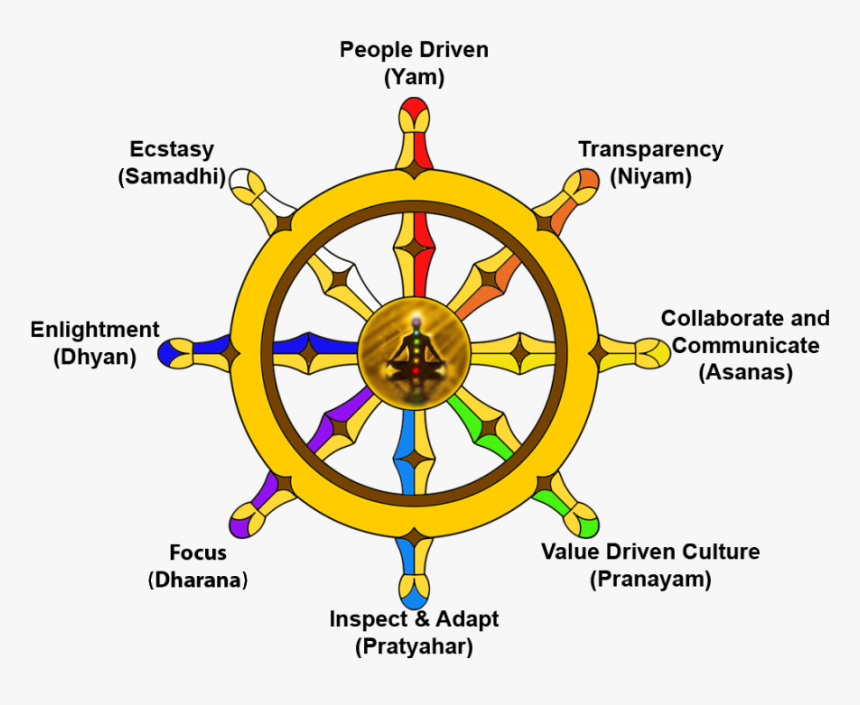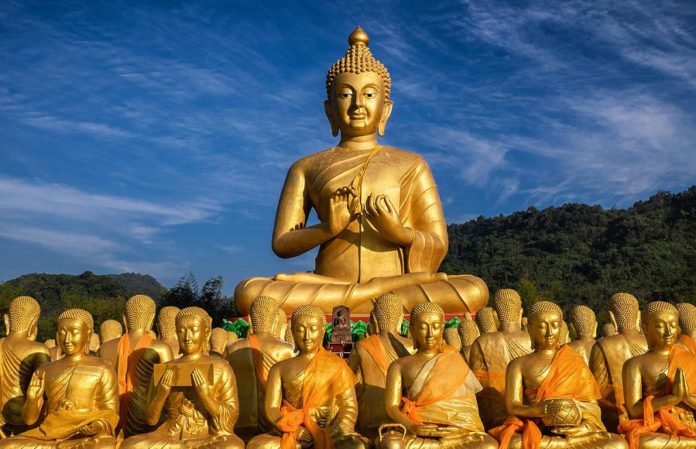Buddhism like Jainism is a religion that arose out of critique of Vedic Hinduism. Like Jainism it does not propagate a God. It is a religion or rather a philosophy based on the original teachings attributed to Gautama Buddha. Gautama Buddha was born in Lumbini, present-day Nepal. He renounced material life because he thought that life was subject to old age, disease and death and that there might be something better, namely liberation from the circle of rebirths reaching Nirvana, a state of perfect quietude, freedom, highest happiness as well as the liberation from attachment and worldly suffering. After years of wandering around in northern India enlightenment or revelation came to him sitting under a tree in Bodh Gaya, a place in Bihar. From here he developed his teachings and started preaching.
As a religion Buddhism started between the 4th and 6th c. BC; it became prominent in India when Vedic Hinduism faltered. It reached its highest development and reach during the Maurya Empire under king Ashoka in the 3rd c. BC. The practice of Buddhism as a distinct and organized religion lost influence after the Gupta reign (c.7th century AD), and the last state to support it, the Pala Empire, fell in the 12th century. It was challenged by the re-emergence of Hinduism and the rise in the socio-political influence of the Brahmins. By the end of the 12th century, it had largely disappeared in the subcontinent with the exception of the Himalayan region and isolated remnants in parts of south India.

In the basis of Buddhist belief lie the idea of the Four Truth; Dukkha, Samsara, Nirvana and the “Eightfold Path”. We crave and cling to impermanent states and things in this world, which is considered by Buddhism as Dukkha, “incapable of satisfying and painful”. This keeps us caught in Saṃsara, the endless cycle of repeated rebirth, dukkha and dying again. But there is a way to liberation from this endless cycle to the state of Nirvana, namely following the Noble Eightfold Path. The Eightfold Path consists of eight practices: right view, right resolve, right speech, right conduct, right livelihood, right effort, right mindfulness, and right samadhi (‘meditative absorption or union’).
To attain liberation from the circle of rebirth a Buddhist had to live a quite ascetic life. Renouncing the world includes renouncing all riches and holding on only to very basic property like the cloths one wears, a bowl for food one is given. The saying “to break one’s begging bowl” relates to this feature of Buddhism. The ascetic streak in Buddhism makes it clear that not everybody could live according to these tenets. Otherwise, who would produce the food to beg for? In practical life at the time when Buddhism was widely practised that must have meant that alongside a number of monks and nuns there must have been people who went after their daily work venerating the monks and nuns by giving alms and performing rituals. Among the rituals meditation played an important part. Buddhist places for those rituals are called stupa (heap). A stupa is a mound-like or hemispherical structure containing relics for veneration. Circumambulation (going around the stupa while praying) is an important part of Buddhism. One other important feature of Buddhism is the idea of equality of men. Other than in Hinduism where the caste system has erected insurmountable borders between men constructing a hierarchical society that keeps a majority at the bottom of the social ladder Buddhism rejected especially this part of Hinduism. Some scholars opine that Islam that came to the subcontinent from the 7th c. onwards when Buddhism withdrew was able to spread in the fringe areas of India where Buddhism had ruled because Islam shared the idea of equality of men with Buddhism and was thus acceptable to former Buddhists rather than to Hindus.
Today’s northern Pakistan and Afghanistan as well as north-eastern India are important places where Buddhism once strived even when in the central subcontinent is was already retreating and spreading out of South Asia. Unfortunately, these Buddhist places have been neglected badly. Not only has been done hardly anything to preserve them, but the history of Buddhism and its common streaks with Islam have not been included into the curriculum. Buddhism is an important part of the local legacy of this region.

Since the 19th century, modern revivals of Buddhism in India have included the Maha Bodhi Society (founded in 1891), the Dalit Buddhist movement founded by Dr. Ambedkar in 1956. Ambedkar was an Indian jurist, economist, politician and social reformer, who inspired the Dalit Buddhist movement and campaigned against social discrimination towards the untouchables (Dalits). He was British India’s Minister of Labour in Viceroy’s Executive Council, Chairman of the Constituent Drafting committee, independent India’s first Minister of Law and Justice, and considered the chief architect of the Constitution of India. Ambedkar reinterpreted Buddhism quite a bit for his purpose. According to him, several of the core beliefs and doctrines of traditional Buddhist traditions such as the Four Noble Truths and Anatta were flawed and pessimistic, and may have been inserted into the Buddhist scriptures by wrong-headed Buddhist monks of a later era. These should not be considered as Buddha’s teachings in Ambedkar’s view. Other foundational concepts of Buddhism such as Karma and Rebirth were considered by Ambedkar as superstitions. Nearly half a million Dalits formerly untouchables joined him and converted to Navayana Buddhism mainly because it rejected Hinduism, challenged the caste system in India and promoted the rights of the Dalit community.
While Buddhism was receding in India making way for a renewal of Hinduism it started spreading north and east through much of Asia. It is the world’s fourth-largest religion with over 520 million followers, or over 7% of the global population. According to the 2011 Census there are 8.4 million Buddhists in India (0.70% of the total population). Two major extant branches of Buddhism are generally recognized by scholars: Theravāda Buddhism (meaning “School of the Elders”) and Mahāyāna Buddhism (meaning “Great Vehicle”). Theravada has a widespread following in Sri Lanka and Southeast Asia such as Cambodia, Laos, Myanmar and Thailand. Mahayana, which includes the traditions of Zen, Pure Land, Nichiren Buddhism, Tiantai Buddhism, and Shingon, is practiced prominently in Nepal, Malaysia, Bhutan, China, Japan, Korea, Vietnam, and Taiwan. Vajrayana, a body of teachings attributed to Indian adepts, may be viewed as a separate branch or as an aspect of Mahayana Buddhism. Tibetan Buddhism, which preserves the Vajrayana teachings of eighth-century India, is practised in the countries of the Himalayan region, Mongolia and Kalmykia. Historically, until the early 2nd millennium, Buddhism was also widely practised in Afghanistan and it also had a foothold to some extent in other places including the Philippines, the Maldives, and Uzbekistan.
Contributed by:

Dr. Bettina Robotka, former Professor of South Asian Studies, Humboldt University, Berlin, Editor of the Defence Journal and a Consultant to the Pathfinder Group.





